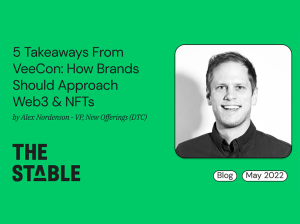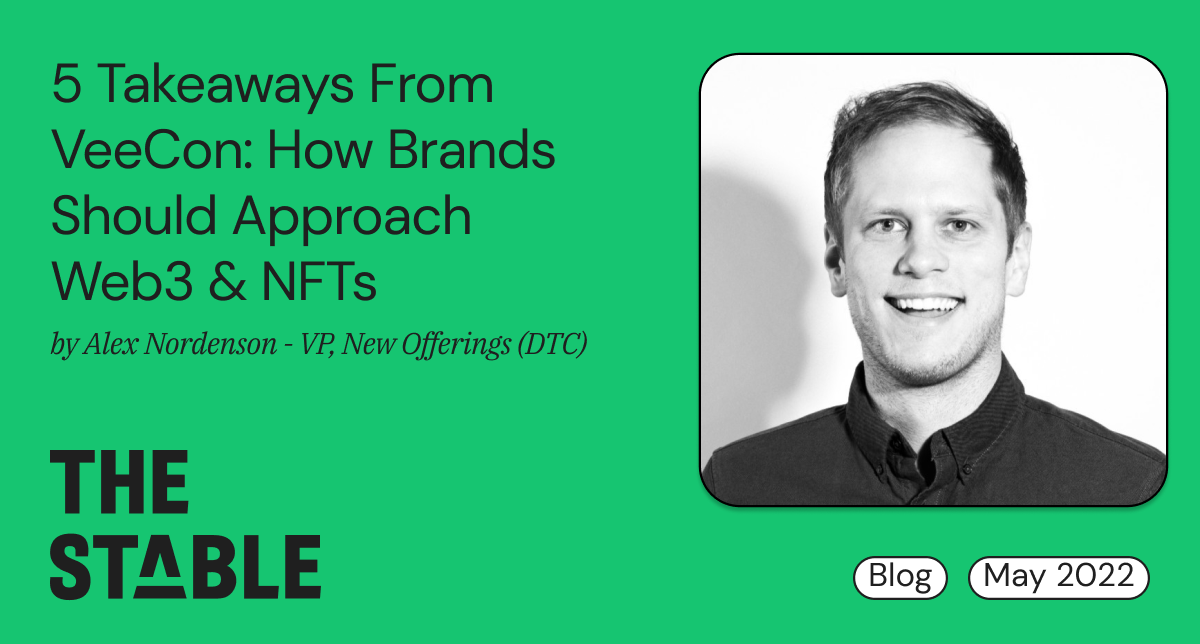Category
Tags
by Alex Norden, VP of New Offerings (DTC) at The Stable
Companies of all shapes and sizes are trying to make sense of Web3. What’s so different from Web2? Wait, is the metaverse already here – and does Mark Zuckerberg run it? Should I launch an NFT project to stay relevant? What about all the crypto volatility and scams I hear about? How soon will all of this actually impact my business?
These questions are all valid, and given we’re just at the tip of the iceberg of what this buzzing topic will likely become, there will be many, many more.
One of the best things you can do to efficiently check the pulse of an industry or area of technology is to attend a conference. VeeCon, Gary Vaynerchuk’s inaugural but much-hyped Web3 and NFT conference, came to Minneapolis’ US Bank Stadium this past weekend, so I brought my boots to the ground.
If you’re not familiar with Vaynerchuk, he is the founder and active CEO of VaynerMedia, the Chairman of independent holding company VaynerX (one arm of which is VaynerNFT), and more recently, the Creator/Founder of VeeFriends, an NFT collection featuring 10,000+ individual pieces and a floor price of 8.49 ETH (that’s worth over $17,000 at this moment). He’s also a well-known tech investor and wildly popular entrepreneurism and marketing influencer on social media.
In order to attend VeeCon, you needed to be a VeeFriends owner OR buy an NFT ticket through OpenSea – currently the biggest online marketplace for NFTs. The conference featured a lineup of speakers across the technology, entertainment, business, and art worlds including the CMO of Pepsi, the Founder and CEO of fitness DTC brand, Gymshark, prominent venture capitalists, and celebrities with their own Web3 projects, like Pharell Williams, Eva Longoria, and Spike Lee.
Here were my five takeaways from VeeCon for growing businesses, whether DTC-only, retail-only, or more omnichannel:
We are still very early, but that will change in the next 1-3 years
A survey published in March found that only 50% of people who do not own crypto are aware of what an NFT is, and that number drops to 21% when it comes to awareness of the larger “Web3” blanket term.
It can be misleading when there is so much excitement and chatter from certain pockets of the internet and economy, and it’s important for any company planning a move with NFTs, digital merchandise, or crypto payments (whether you’re an upstart beauty brand or an established CPG) to set the right expectations from the outset. For the time being, this isn’t a mass opportunity, but paradigm shifts don’t happen overnight so it’s still the time to start testing.
The opportunity today, while ultimately dependent on your company or brand, is to build a foundation of learning in a space that is quickly picking up steam, grow your connection within a big area of interest for Millennial and Gen Z consumers, and test out new forms of commerce that might play a dominant role in the future of your business (whether it be on the marketing side, payments, product, partnerships, or all of the above.)
Four years ago, pretty much the only NFT project alive was “Crypto Kitties.” And, while many VeeCon speakers and leaders in the space still criticize the user experience and learning curve friction of Web3 commerce, fast forward to 2022 and you have:
- Major investors placing big bets on Web3 (Andreeson Horowitz, Sequoia, e.g.), totaling $27 billion in 2021 alone
- Public crypto companies that are also launching NFT marketplaces (Coinbase)
- Global advertising powerhouses minting NFTs that are selling for hundreds of thousands of dollars (Pepsi)
- Huge commerce platforms launching NFT betas (Shopify)
- Oscar-winning filmmakers like Spike Lee using Web3 to monetize their fans and build community around their art in new ways
- Oh, and NFT-gated conferences
All signs point to: we’re heading somewhere new, and we’ll be there sooner than we think. So, buckle up.
Web2 isn’t just going to go away

“People want a neighborhood, not a town square. That’s what’s broken about Web2 right now.” These were the words and perspective of Brit Morin, Co-Founder of BFF and Offline Ventures, who spoke on Friday’s VeeCon panel Web2 vs. Web3. Her husband, Dave Morin, was an early employee at Facebook (and founder of now defunct “small-group” social media app Path, a personal favorite of mine), bringing them both to the ground floor of Web2’s rise to power early in the 2010s.
Brit’s thoughts signal a major gripe with our current internet economy that came up quite a bit in VeeCon sessions throughout the weekend: people really love community, and Web2’s victors didn’t…actually provide that. From commerce, to art, to marketing, Web3 opens the door for fans and customers to connect in new ways and gain authority (both economic and otherwise) that they never had in the Web2 era. But still, companies like Google and Facebook are going to be very important technology companies placing big bets in Web3 themselves, so we’re in for an interesting blending of worlds.
While we might all be logging in with our digital wallets to every social platform or eCommerce site we visit in a matter of a few years, there won’t be a clear line separating the old web from the new. And, given the many benefits of a more centralized system for consumers and businesses, that’s probably not a bad thing.
This is the beginning of a new consumer
This was probably the most striking theme to emerge all weekend: the consumer is truly changing. The rise of Web3 is coinciding with a shift in mindset for those of us who are spending money on products, media, and services every day. We want a say; we don’t want the same old advertising targeting us, we want the ability to create and not just consume; we want an economic stake; we want to be a part of something. This new consumer isn’t going to wait for us to tell them what they should be doing, thinking or buying. They think about marketing very differently.
One of the most exciting elements of this “new consumer” is their eagerness to support a new product launch or idea at its earliest stages. For brands creating physical products, this is a fascinating time to think about how NFTs can give unique access or input channels to your biggest customers during your product development cycle. Additionally, how can you start blending your online and offline communities to fit the new shift in omnichannel consumer mentality?
But the most important thing? Staying authentic to who you are and the real value you bring to the table. According to Huda Kattan, founder of popular cosmetics line, Huda Beauty, who spoke on Saturday’s panel about women in Web3, “Brands getting into the space need to be able to answer the question, why are you here?”
Start thinking about “margin innovation”
Traditionally, companies strategize about how to increase their margins through means such as “cutting fat” within operations or making better deals with manufacturers and supply partners. Within the Web2 context, you might grow your margins by moving your company’s data to the cloud or consolidating your email and SMS marketing with one provider.
But what about in the new Web3 context? Gareth Everard, CMO at sustainable electronics accessory company, Pela, spoke on a Friday panel about Revolutionizing Commerce and introduced the audience to a phrase his team is using internally: “margin innovation.” I interpret the term to mean applying creativity and technology to construct margin out of, more or less, thin air, while paying careful attention to value.
When it comes to Web3, one example he gave to illustrate this concept is producing iPhone cases with one-of-a-kind artwork printed on the back, each of which is associated with an NFT of the original digital art file. This approach adds longer-lasting value to the physical product his company sells, presumably commanding a higher price point than would otherwise be feasible, while also increasing affinity and loyalty to the brand (i.e. longer-term margin expansion). In addition, this company gains the ability to reap additional revenue on that same sale if a re-selling royalty is baked into the smart contract for that NFT.
The bottom line is, companies in all categories of commerce need product innovation and new ways of creating margin growth. Many beauty brands, and even celebrity brands like Martha Stewart, are experimenting in this area already. Margin strategy may not typically be where the creatives in your organization can shine, but it’s about time to rethink that if you want to be prepared for the future of commerce.
Now is the time to educate yourself
This came up time and time again, from Vaynerchuk himself, to digital creators minting their own NFTs, to Bay Area investors. Before you go launching anything with your brand on it, or dropping thousands on a new hot-shot NFT project, get comfortable with the players and principles in the space, read about projects that have both failed and succeeded, and form a clear perspective on what problems blockchains can solve and what problems they can’t. With the current crypto bear market especially, now is the perfect time to learn, meet with potential partners, consult with the agencies you trust most…and then start building.
Talk to Us
Interested in discussing how Web3 and NFTs may generate new growth opportunities for your brand? Reach out to discuss any eCommerce and digital projects your brand might be interested in.




